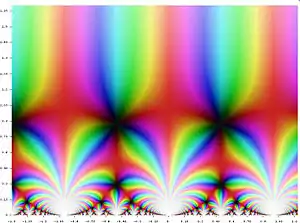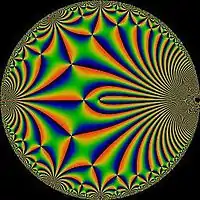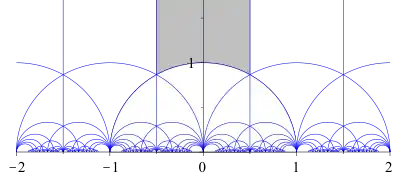j-invariant
In mathematics, Felix Klein's j-invariant or j function, regarded as a function of a complex variable τ, is a modular function of weight zero for SL(2, Z) defined on the upper half-plane of complex numbers. It is the unique such function which is holomorphic away from a simple pole at the cusp such that

Rational functions of j are modular, and in fact give all modular functions. Classically, the j-invariant was studied as a parameterization of elliptic curves over C, but it also has surprising connections to the symmetries of the Monster group (this connection is referred to as monstrous moonshine).
Definition


The j-invariant can be defined as a function on the upper half-plane H = {τ ∈ C, Im(τ) > 0},
where:
- (the modular discriminant)
This can be motivated by viewing each τ as representing an isomorphism class of elliptic curves. Every elliptic curve E over C is a complex torus, and thus can be identified with a rank 2 lattice; that is, a two-dimensional lattice of C. This lattice can be rotated and scaled (operations that preserve the isomorphism class), so that it is generated by 1 and τ ∈ H. This lattice corresponds to the elliptic curve (see Weierstrass elliptic functions).
Note that j is defined everywhere in H as the modular discriminant is non-zero. This is due to the corresponding cubic polynomial having distinct roots.
The fundamental region

It can be shown that Δ is a modular form of weight twelve, and g2 one of weight four, so that its third power is also of weight twelve. Thus their quotient, and therefore j, is a modular function of weight zero, in particular a holomorphic function H → C invariant under the action of SL(2, Z). Quotienting out by its centre { ±I } yields the modular group, which we may identify with the projective special linear group PSL(2, Z).
By a suitable choice of transformation belonging to this group,
we may reduce τ to a value giving the same value for j, and lying in the fundamental region for j, which consists of values for τ satisfying the conditions
The function j(τ) when restricted to this region still takes on every value in the complex numbers C exactly once. In other words, for every c in C, there is a unique τ in the fundamental region such that c = j(τ). Thus, j has the property of mapping the fundamental region to the entire complex plane.
Additionally two values τ,τ' ∈H produce the same elliptic curve iff τ = T(τ') for some T ∈ PSL(2, Z). This means j provides a bijection from the set of elliptic curves over C to the complex plane.[1]
As a Riemann surface, the fundamental region has genus 0, and every (level one) modular function is a rational function in j; and, conversely, every rational function in j is a modular function. In other words, the field of modular functions is C(j).
Class field theory and j
The j-invariant has many remarkable properties:
- If τ is any CM point, that is, any element of an imaginary quadratic field with positive imaginary part (so that j is defined), then j(τ) is an algebraic integer.[2] These special values are called singular moduli.
- The field extension Q[j(τ), τ]/Q(τ) is abelian, that is, it has an abelian Galois group.
- Let Λ be the lattice in C generated by {1, τ}. It is easy to see that all of the elements of Q(τ) which fix Λ under multiplication form a ring with units, called an order. The other lattices with generators {1, τ′}, associated in like manner to the same order define the algebraic conjugates j(τ′) of j(τ) over Q(τ). Ordered by inclusion, the unique maximal order in Q(τ) is the ring of algebraic integers of Q(τ), and values of τ having it as its associated order lead to unramified extensions of Q(τ).
These classical results are the starting point for the theory of complex multiplication.
Transcendence properties
In 1937 Theodor Schneider proved the aforementioned result that if τ is a quadratic irrational number in the upper half plane then j(τ) is an algebraic integer. In addition he proved that if τ is an algebraic number but not imaginary quadratic then j(τ) is transcendental.
The j function has numerous other transcendental properties. Kurt Mahler conjectured a particular transcendence result that is often referred to as Mahler's conjecture, though it was proved as a corollary of results by Yu. V. Nesterenko and Patrice Phillipon in the 1990s. Mahler's conjecture was that if τ was in the upper half plane then e2πiτ and j(τ) were never both simultaneously algebraic. Stronger results are now known, for example if e2πiτ is algebraic then the following three numbers are algebraically independent, and thus at least two of them transcendental:
The q-expansion and moonshine
Several remarkable properties of j have to do with its q-expansion (Fourier series expansion), written as a Laurent series in terms of q = e2πiτ (the square of the nome), which begins:
Note that j has a simple pole at the cusp, so its q-expansion has no terms below q−1.
All the Fourier coefficients are integers, which results in several almost integers, notably Ramanujan's constant:
- .
The asymptotic formula for the coefficient of qn is given by
- ,
as can be proved by the Hardy–Littlewood circle method.[3][4]
Moonshine
More remarkably, the Fourier coefficients for the positive exponents of q are the dimensions of the graded part of an infinite-dimensional graded algebra representation of the monster group called the moonshine module – specifically, the coefficient of qn is the dimension of grade-n part of the moonshine module, the first example being the Griess algebra, which has dimension 196,884, corresponding to the term 196884q. This startling observation, first made by John McKay, was the starting point for moonshine theory.
The study of the Moonshine conjecture led John Horton Conway and Simon P. Norton to look at the genus-zero modular functions. If they are normalized to have the form
then John G. Thompson showed that there are only a finite number of such functions (of some finite level), and Chris J. Cummins later showed that there are exactly 6486 of them, 616 of which have integral coefficients.[5]
Alternate expressions
We have
where x = λ(1 − λ) and λ is the modular lambda function
a ratio of Jacobi theta functions θm, and is the square of the elliptic modulus k(τ).[6] The value of j is unchanged when λ is replaced by any of the six values of the cross-ratio:[7]
The branch points of j are at {0, 1, ∞}, so that j is a Belyi function.[8]
Expressions in terms of theta functions
Define the nome q = eπiτ and the Jacobi theta function,
from which one can derive the auxiliary theta functions. Let,
where θm and ϑn are alternative notations, and a4 − b4 + c4 = 0. Then,
for Weierstrass invariants g2, g3, and Dedekind eta function η(τ). We can then express j(τ) in a form which can rapidly be computed.
Algebraic definition
So far we have been considering j as a function of a complex variable. However, as an invariant for isomorphism classes of elliptic curves, it can be defined purely algebraically.[9] Let
be a plane elliptic curve over any field. Then we may perform successive transformations to get the above equation into the standard form y2 = 4x3 − g2x − g3 (note that this transformation can only be made when the characteristic of the field is not equal to 2 or 3). The resulting coefficients are:
where g2 = c4 and g3 = c6. We also have the discriminant
The j-invariant for the elliptic curve may now be defined as
In the case that the field over which the curve is defined has characteristic different from 2 or 3, this is equal to
Inverse function
The inverse function of the j-invariant can be expressed in terms of the hypergeometric function 2F1 (see also the article Picard–Fuchs equation). Explicitly, given a number N, to solve the equation j(τ) = N for τ can be done in at least four ways.
Method 1: Solving the sextic in λ,
where x = λ(1 − λ), and λ is the modular lambda function so the sextic can be solved as a cubic in x. Then,
for any of the six values of λ.
Method 2: Solving the quartic in γ,
then for any of the four roots,
Method 3: Solving the cubic in β,
then for any of the three roots,
Method 4: Solving the quadratic in α,
then,
One root gives τ, and the other gives −1/τ, but since j(τ) = j(−1/τ), it makes no difference which α is chosen. The latter three methods can be found in Ramanujan's theory of elliptic functions to alternative bases.
The inversion applied in high-precision calculations of elliptic function periods even as their ratios become unbounded. A related result is the expressibility via quadratic radicals of the values of j at the points of the imaginary axis whose magnitudes are powers of 2 (thus permitting compass and straightedge constructions). The latter result is hardly evident since the modular equation of level 2 is cubic.
Pi formulas
The Chudnovsky brothers found in 1987,[10]
which uses the fact that
For similar formulas, see the Ramanujan–Sato series.
Special values
The j-invariant vanishes at the "corner" of the fundamental domain at
Here are a few more special values given in terms of the alternative notation J(τ) ≡ 1/1728 j(τ) (only the first four of which are well known):
Failure to classify elliptic curves over other fields
The -invariant is only sensitive to isomorphism classes of elliptic curves over the complex numbers, or more generally, an algebraically closed field. Over other fields there exist examples of elliptic curves whose -invariant is the same, but are non-isomorphic. For example, let be the elliptic curves associated to the polynomials
both have -invariant . Then, the rational points of can be computed as
since
and for , there are only irrational points
for . This can be shown using Cardano's formula. On the other hand, contains the set of points
since the equation of gives the equation
For there is the solution , so assume . Then, dividing the equation by gives
which can be rewritten as the quadratic equation
Using the quadratic formula, this gives
hence it is a rational number. Now, if these curves are considered over , there is an isomorphism sending
References
- Gareth A. Jones and David Singerman. (1987) Complex functions: an algebraic and geometric viewpoint. Cambridge UP.
- Silverman, Joseph H. (1986). The Arithmetic of Elliptic Curves. Graduate Texts in Mathematics. 106. Springer-Verlag. p. 339. ISBN 978-0-387-96203-0. Zbl 0585.14026.
- Petersson, Hans (1932). "Über die Entwicklungskoeffizienten der automorphen Formen". Acta Mathematica. 58 (1): 169–215. doi:10.1007/BF02547776. MR 1555346.
- Rademacher, Hans (1938). "The Fourier coefficients of the modular invariant j(τ)". American Journal of Mathematics. 60 (2): 501–512. doi:10.2307/2371313. JSTOR 2371313. MR 1507331.
- Cummins, Chris J. (2004). "Congruence subgroups of groups commensurable with PSL(2,Z)$ of genus 0 and 1". Experimental Mathematics. 13 (3): 361–382. doi:10.1080/10586458.2004.10504547. ISSN 1058-6458. S2CID 10319627. Zbl 1099.11022.
- Chandrasekharan (1985) p.108
- Chandrasekharan, K. (1985), Elliptic Functions, Grundlehren der mathematischen Wissenschaften, 281, Springer-Verlag, p. 110, ISBN 978-3-540-15295-8, Zbl 0575.33001
- Girondo, Ernesto; González-Diez, Gabino (2012), Introduction to compact Riemann surfaces and dessins d'enfants, London Mathematical Society Student Texts, 79, Cambridge: Cambridge University Press, p. 267, ISBN 978-0-521-74022-7, Zbl 1253.30001
- Lang, Serge (1987). Elliptic functions. Graduate Texts in Mathematics. 112. New-York ect: Springer-Verlag. pp. 299–300. ISBN 978-1-4612-9142-8. Zbl 0615.14018.
- Chudnovsky, David V.; Chudnovsky, Gregory V. (1989), "The Computation of Classical Constants", Proceedings of the National Academy of Sciences of the United States of America, 86 (21): 8178–8182, doi:10.1073/pnas.86.21.8178, ISSN 0027-8424, JSTOR 34831, PMC 298242, PMID 16594075.
- Apostol, Tom M. (1976), Modular functions and Dirichlet Series in Number Theory, Graduate Texts in Mathematics, 41, New York: Springer-Verlag, MR 0422157. Provides a very readable introduction and various interesting identities.
- Apostol, Tom M. (1990), Modular functions and Dirichlet Series in Number Theory, Graduate Texts in Mathematics, 41 (2nd ed.), doi:10.1007/978-1-4612-0999-7, ISBN 978-0-387-97127-8, MR 1027834
- Berndt, Bruce C.; Chan, Heng Huat (1999), "Ramanujan and the modular j-invariant" (PDF), Canadian Mathematical Bulletin, 42 (4): 427–440, doi:10.4153/CMB-1999-050-1, MR 1727340, archived from the original (PDF) on 2007-09-29. Provides a variety of interesting algebraic identities, including the inverse as a hypergeometric series.
- Cox, David A. (1989), Primes of the Form x^2 + ny^2: Fermat, Class Field Theory, and Complex Multiplication, New York: Wiley-Interscience Publication, John Wiley & Sons Inc., MR 1028322 Introduces the j-invariant and discusses the related class field theory.
- Conway, John Horton; Norton, Simon (1979), "Monstrous moonshine", Bulletin of the London Mathematical Society, 11 (3): 308–339, doi:10.1112/blms/11.3.308, MR 0554399. Includes a list of the 175 genus-zero modular functions.
- Rankin, Robert A. (1977), Modular forms and functions, Cambridge: Cambridge University Press, ISBN 978-0-521-21212-0, MR 0498390. Provides a short review in the context of modular forms.
- Schneider, Theodor (1937), "Arithmetische Untersuchungen elliptischer Integrale", Math. Annalen, 113: 1–13, doi:10.1007/BF01571618, MR 1513075, S2CID 121073687.
